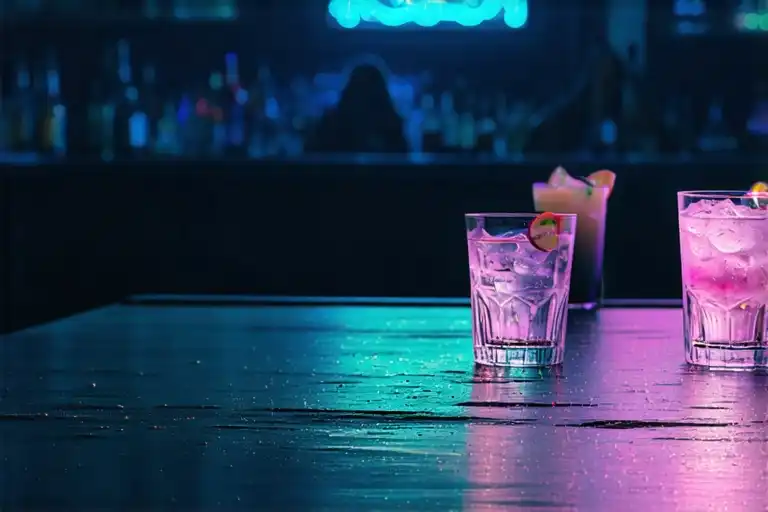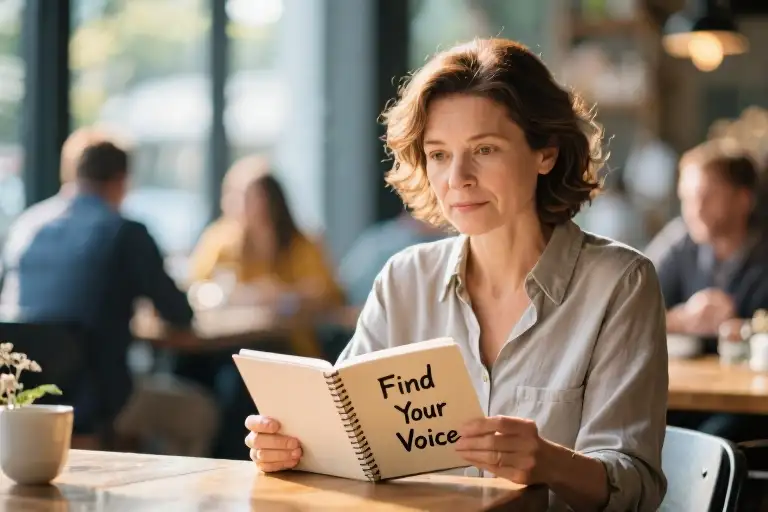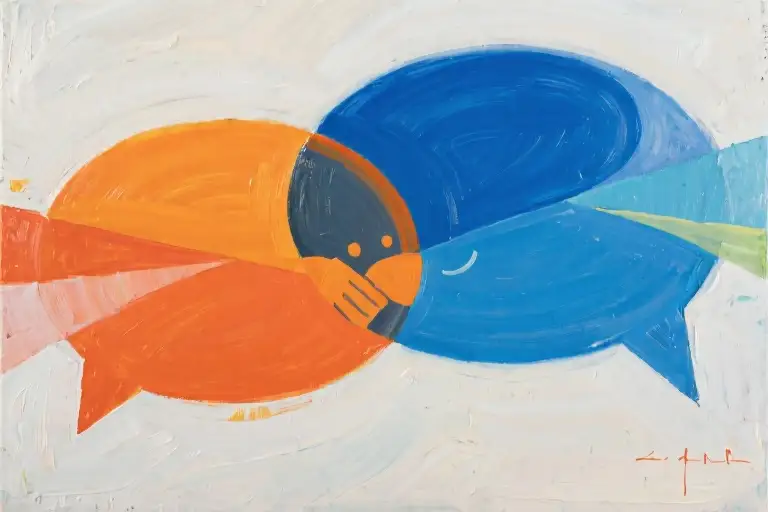There’s a tingling in my fingers that has nothing to do with the drink in my hand. The bass pulses through the floorboards like a distress signal, each thump syncing with my erratic heartbeat. Around me, a sea of Gen Z bodies moves with instinctual rhythm—shoulders loose, hips fluid, all effortless grace in the strobe-lit darkness. At five-foot-four, I’m eye-level with most of their collarbones.
A whiff of coconut vape juice and synthetic musk triggers a visceral memory: high school gymnasiums circa 2003, Abercrombie-clad teens swaying to Dashboard Confessional. But tonight, the nostalgia offers no comfort. My breath hitches as a six-foot-something in an oversized graphic tee brushes past, his laughter cutting through the music like he’s privy to some generational joke I’ll never understand. The millennial bug strikes again—that glitch in the system where your body occupies contemporary space while your psyche remains trapped in a dial-up era.
Somewhere in the 2018 archives of my literature degree, there’s an answer to why crowded rooms still make my skin prickle. Back then, I wrote about agoraphobia with clinical detachment, mistaking raw vulnerability for weakness. The girl who drafted those essays would’ve bolted from this dance floor already. Tonight, I stay—not because the fear has vanished, but because I’ve learned to translate its language.
The DJ transitions into a TikTok-viral track, and suddenly the room erupts in coordinated moves my thirty-something muscles can’t replicate. A chorus of whoops rises as someone starts filming. My thumbs twitch with phantom muscle memory—not for dance, but for the instinct to pull out a Nokia and text ‘SOS’ to equally awkward friends. Instead, I press my sweating palms against my jeans and catalog the details: the way strobe lights fracture across gold hoop earrings, how the bassline vibrates my molars, the acidic tang of adrenaline at the back of my throat. These sensations will become sentences later, when I’m safe at my desk with chamomile tea and the soft glow of a word processor.
For now, I’m just a woman in a room full of strangers, learning that sometimes belonging isn’t about fitting in—it’s about bearing witness.
The Trembling Outsider
My fingers tingle with an electric discomfort that has nothing to do with the vodka tonic sweating in my hand. The sensation crawls up my wrists like tiny spiders spinning panic threads beneath my skin. Around me, the dance floor pulses with bodies that move with instinctive rhythm—a synchronized swarm of Gen Z confidence that makes me acutely aware of every unnatural twitch in my shoulders.
A drop of sweat traces my spine, cold against the humid air thick with the scent of vanilla vape juice and hormonal fermentation. The bassline throbs at 120 BPM while my heart stutters at 145, stubbornly refusing to sync with the music’s artificial heartbeat. Each inhalation tastes like cheap perfume and adolescent pheromones, the same cocktail that haunted high school dances twenty years ago—yet somehow more alien now than then.
These kids (because that’s what they are, really) move with a physical vocabulary I’ll never speak fluently. Their limbs articulate TikTok choreography while mine remember the stiff sway of millennial wedding receptions. At 5’7″, I’ve become an island in a rising sea of post-2000 genetics—their superior height advantage making me feel like evolution’s afterthought. My nervous system broadcasts error messages: System incompatibility detected. Social protocol mismatch.
The DJ drops the beat and a collective scream ripples through the crowd—a sound so visceral it vibrates in my molars. Someone’s elbow grazes my arm and I flinch like touched by live wire. This isn’t fear of the space (though my therapist would call it agoraphobia), but fear of being the glitch in this human software. My body has become a museum exhibit: Millennial specimen in natural habitat (circa 1999). Note the distressed denim and inappropriate footwear for dancing.
Between strobing lights, I catch my reflection in a mirrored column—a pixelated ghost superimposed on these vibrant bodies. The realization hits like a missed stair step: I’m not just uncomfortable, I’m archaeologically out of place. My kind were designed for AIM away messages and MySpace top friends, not this fluid ecosystem of Snapchat streaks and infinite scrolling.
Yet beneath the panic, something curious happens. The very awareness of my otherness becomes a perverse anchor. My trembling hands? Proof I haven’t gone numb. The sweat cooling on my neck? A receipt for showing up. In this sea of effortless belonging, my discomfort is the most authentic thing here—a raw, unfiltered signal in a room full of perfectly curated noise.
Perhaps this is what they never tell you about anxiety disorders—that the symptoms are just your body’s clumsy love language, desperate to remind you you’re alive in a world that increasingly feels like someone else’s operating system. The music swells again, and for three glorious seconds, my heartbeat syncs with the kick drum. Progress.
The Revision Mode of Time
My professor’s red pen hovered like a surgeon’s scalpel over my agoraphobia essay in that sunlit seminar room. “Raw honesty isn’t the same as art,” she’d written in the margin, her cursive looping like an EKG of my creative growing pains. The 2018 version of me had believed emotional truth required unfiltered exposure—as if stripping away all literary devices would somehow bring readers closer to my panic attacks.
Here’s how twenty-three-year-old me described a grocery store meltdown in the original draft:
My hands shook so bad the shopping basket rattled. Everyone’s eyes were lasers burning through my clothes. I counted the tiles—37 from dairy to exit—while my lungs forgot how lungs work. The cashier said ‘paper or plastic’ and I almost cried because choosing meant staying longer.
Reading it now, I recognize the authenticity but also the missed opportunities. That draft was a Polaroid snapped during the earthquake, while the revised version became a stained-glass window—the same light refracted through craftsmanship. My professor challenged me to translate physiological terror into something that could resonate beyond my own nervous system.
What emerged was this passage, written six months later:
The supermarket fluorescents hummed at a frequency that made my teeth ache. Aisles stretched into impossible perspectives like a Dalí painting, cereal boxes grinning with cartoon mascots. When the intercom announced a cleanup on aisle three, I became certain the voice meant me—some emotional spill requiring containment. My fingers memorized the braille of every item as if touch could anchor me to consensus reality.
This evolution captures the tension all personal essayists face: how to honor lived experience while transforming it into shared meaning. Those early drafts mistook intensity for intimacy, assuming readers would connect with unprocessed emotion rather than crafted revelation.
Three key lessons emerged from this archival excavation of my writing process:
- Sensory translation—Converting bodily reactions into environmental metaphors (teeth-aching fluorescents) creates bridges for readers who haven’t experienced agoraphobia
- Perspective alchemy—Blending first-person immediacy with observational distance (noting the Dalí-like distortion) allows simultaneous immersion and reflection
- Generational context—Recognizing how my millennial references (Polaroid, Dalí) might need calibration for Gen Z readers without compromising voice
My professor’s marginalia haunts me still: “Make us feel your isolation, not just witness it.” That distinction became my compass—not just in writing about anxiety, but in navigating the generational divides that often trigger it. The same skills that helped me reframe panic attacks now help decode why a roomful of Gen Z dancers makes my breath shorten: it’s not (just) the crowd, but the acute awareness of being an archived version of humanity.
Perhaps this is why we revise—not to dilute our truths, but to build the linguistic infrastructure that allows others to visit them. Every essay becomes a time capsule, preserving both what we experienced and how we learned to communicate it across the growing distances between our selves, our audiences, and our eras.
The Time Lag Syndrome
The dance floor’s strobe lights freeze-frame a generational divide. Where Z-fluent bodies move in TikTok-perfected gestures, my millennial hips default to an awkward two-step last updated in 2012. This isn’t just about dance moves—it’s about entire operating systems for human connection.
The Social Media Handshake vs. The Email Etiquette Manual
Z世代 (Gen Z) approaches interactions like swiping through Instagram Stories—ephemeral, visual, and punctuated with reaction emojis. Their conversations live in disappearing Snapchat streaks and Discord threads that scroll into oblivion. Meanwhile, my people still draft emails with “Dear [Name],” and mentally compose subject lines worthy of New Yorker headlines. A 2022 Pew Research study found 60% of millennials experience “cultural latency” in cross-generational communication—that microsecond delay before realizing your carefully crafted email signature reads like hieroglyphics to someone who communicates via meme reactions.
The Body Language Divide
Observe any Gen Z gathering and you’ll witness a new lexicon of physical cues: AirPods as social force fields, hoodies drawn up like drawbridges, the subtle wrist-flip that means “record this for TikTok.” My generation? We still do the “hover hand” in group photos and apologize when someone bumps into us. The supermarket became my generational battleground last week when a cashier half my age greeted me with “Yo, what’s good?” My brain short-circuited between “Respond in kind” and “Maintain professional decorum”—resulting in a bizarre hybrid: “The weather is… satisfactory, young citizen.”
The Feedback Loop Paradox
Here’s where the anxiety amplifies: Z世代 developed their social skills through like counts and view metrics, creating what psychologists call “quantified validation.” Millennials remember when “going viral” meant catching the flu. Our childhood feedback came in handwritten notes passed during algebra—no edit button, no delete function. When my 19-year-old intern suggested revising a project based on “vibes,” I had to suppress the urge to ask for a bullet-pointed memo with tracked changes.
Rewiring the Connection
The solution isn’t about who adapts to whom—it’s about finding the shared frequency. Sometimes that means:
- Translating my email drafts into Slack threads
- Recognizing that a thumbs-up emoji can replace three paragraphs of praise
- Understanding their “ghosting” isn’t personal, just efficient
At the club that night, I finally found common ground when a Dua Lipa song bridged our generational playlists. For three minutes, we all moved to the same rhythm—proof that cultural time lags can be overcome, one bass drop at a time.
Archiving the Uncomfortable
The dance floor’s sweat-stained chaos lingers in my fingertips as I sit at my writing desk. That millennial bug still hums in my system – not as panic now, but as creative static waiting to be shaped. This is where personal anxiety narrative transforms; where the stench of adolescent hormones becomes ‘the ferment of generational shift,’ where trembling hands evolve into ‘tremors of time’s friction.’
Preserving the Raw Nerve
My 2018 self would’ve documented the club scene with clinical precision: Heart rate 120 bpm. Palmar hyperhidrosis. Olfactory assault of AXE body spray and Juul pods. The academic exercise missed the crucial layer – how these physical reactions mirrored my generational displacement. Now I understand creative nonfiction tips aren’t about sanitizing experience, but finding the metaphors that let readers taste your reality.
Try this: When describing your own anxiety:
- List 3 sensory details from memory (e.g., ‘the LED lights stung like freezer burn’)
- Then ask: What does this represent beyond myself? (e.g., ‘the cold glow of digital-native socialization’)
The Alchemy of Distance
Time performs unexpected edits. That night’s terror – being surrounded by Gen Z’s effortless belonging – now reads as cultural anthropology. Their TikTok choreography versus my Millennial head-nodding wasn’t just personal awkwardness; it was generational differences essay material waiting to happen. The sweat I’d wiped from my palms became ink stains tracing larger patterns.
“Authenticity isn’t the unedited scream,” my writing professor once noted, “but the carefully placed window where others recognize their own reflection.”
Your Turn: The Sensory Archive
Here’s where we move from observation to practice. Take that moment when you’ve felt like an outsider in a crowd:
- Smell: Did anxiety have a scent? (Mine: synthetic watermelon vape juice over sour beer)
- Texture: How did discomfort physically manifest? (The sequined dress scratching like grade-school name tags)
- Sound: What auditory detail amplified your isolation? (The bass drop that synchronized with everyone but you)
These fragments become your generational Rosetta Stone. My ‘millennial bug’ metaphor emerged from realizing my panic wasn’t just social anxiety – it was the glitch between analog childhood and digital adulthood.
The Courage to Keep the Edges
The temptation is strong to sand down our roughest memories into palatable lessons. Resist it. That club’s sticky floor stays in my essay because viscosity communicates something statistics about agoraphobia writing can’t. When readers later asked, “How did you make me smell that scene?” I knew the truth: I hadn’t invented the stench – I’d simply stopped holding my nose on the page.
So I’ll leave you with this archival challenge: What uncomfortable truth have you been airbrushing from your personal narratives? Sometimes the most powerful generational commentary hides in the details we’re most tempted to delete.
When the Music Stops
The bassline fades into static, leaving my eardrums humming with residual vibrations. Around me, the Z-generation giants disperse like a retreating tide, their laughter and sweat evaporating into the club’s neon haze. My fingers still throb with that peculiar numbness—not from alcohol now, but from the lingering adrenaline of having survived another social collision.
Time has encrypted this moment. I remain the outlier in the archive, but no longer in raw format. The trembling hands, the mismatched heartbeat, the scent of adolescent pheromones—these sensory fragments have been compressed into something more manageable. A narrative. A lesson. A badge of survival.
Writing about anxiety is like reverse-engineering a panic attack. You take the racing pulse and translate it into metaphor. The sweat becomes liquid silver tracing constellations down your spine. The shortness of breath transforms into an invisible hand squeezing your windpipe. But somewhere in that alchemy, you must preserve the original data—the uncomfortable truth that these sensations aren’t poetic devices but physiological facts.
My 2018 self would’ve documented this dance floor episode with clinical precision: Heart rate 120 bpm. Pupils dilated. Muscle tension 8/10. The younger writer in me believed truth lived only in unfiltered reporting. But time—that meticulous archivist—has taught me to appreciate the spaces between facts. How the millennial bug isn’t just a glitch but a generational fingerprint. How being an outsider grants you front-row seats to observe the spectacle of human connection.
As the house lights bleach the room, I catch my reflection in a cocktail glass—distorted but recognizable. The questions linger like afterimages:
When our generational codes finally decrypt, what versions of ourselves will emerge?
Will the archived anxieties become museum pieces or blueprints?
Perhaps the answer lives in the retelling. Not just the what but the how—the way we choose to frame our stumbles through time. Tonight’s discomfort will join the other entries in my mental catalog, not as a failure but as field research. Another data point in the ongoing study of how to move through spaces that weren’t designed for you.
Because the music always stops eventually. The crowds thin. And in that quiet, you get to decide:
Do you file the experience under fear or curiosity?
Under misfit or witness?
The archive keeps growing. And so do we.





